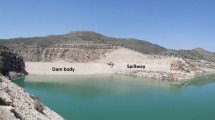Abstract
The paper discusses the investigations into the Khersan 3 Dam site in the Zagros Zone, southern Iran, where the Rig, Shorom and Laki Anticlines meet. The Asmari Limestone is the main aquifer system in the area of the dam site and its reservoir. Marly bands within the Lower Asmari Unit create three confined sub-aquifers under artesian pressure overlain by one unconfined sub-aquifer. The impounded water will be in direct contact with the Asmari Limestone hence leakage may occur through existing karst features. As the recharge zone of the artesian sub-aquifers is higher than the normal water level in the reservoir, no direct leakage through the artesian sub-aquifers is anticipated. However, when the water head in the unconfined sub-aquifer rises with the construction of the dam, leakage may occur and further karstification develop.
Résumé
L’article présente les travaux de reconnaissance réalisés sur le site du barrage de Khersan 3, dans la région du Zagros au sud de l’Iran, au niveau des anticlinaux de Rig, Shorom et Laki. La formation des calcaires d’Asmari est le principal système aquifère au niveau du site du barrage et de son réservoir. Des niveaux marneux dans la partie inférieure de l’unité d’Asmari sont à l’origine de trois nappes captives surmontées par une nappe libre. L’eau de la retenue sera en contact direct avec les calcaires d’Asmari et, de ce fait, des fuites pourront avoir lieu au travers du karst. Comme la zone de recharge des nappes captives est plus haute que le niveau normal du réservoir, on ne craint aucune fuite au travers des aquifères correspondants. Cependant, lorsque la charge hydraulique dans l’aquifère de la nappe libre augmentera avec la construction du barrage, des fuites pourront avoir lieu et la karstification pourra se développer.











Similar content being viewed by others
References
Alavi M (2004) Regional stratigraphy of the Zagros fold-thrust belt of Iran and its proforeland evaluation. Am J Sci 304:1–20
Altug S, Saticioglu Z (2000) Breke Arch Dam, Turkey: hydrogeology, karstification and treatment of limestone foundation. In: Proceeding of the present state and future trends of karst studies, vol. Z1, Marmaries, Turkey, pp315–323
Bakalowicz M (2005) Karst groundwater: a challenge for new resources. Hydrogeol J 13:148–160
Ellins KK (1992) Stable isotopic study of the groundwater of the Martha Brae River Basin, Jamaica. Water Resources Res 28(6):1597–1604
Fazeli MA (2005) Construction of grout curtain in karstic environment case study: Salam Farsi Dam. In: Proceeding of the international conference and field seminars, Belgrade & Kotor (Serbia & Montenegro), 13–19 September 2005, pp 659–666
Ghobadi MH, Khanlari GR, Djalaly H (2005) Seepage problems in the right abutment of the Shahid Abbaspour Dam, southern Iran. Eng Geol 82:119–126
James ER, Manga M, Rose TP, Hudson GB (2000) The use of temperature and isotopes of O, H, C and noble gases to determine the pattern and spatial extent of groundwater flow. J Hydrol 237:100–112
James GA, Wynd JG (1965) Stratigraphic nomenclature of Iranian Oil Consortium Agreement area. Bull Am Assoc Petrol Geol 49(12):2182–2245
Kalkani EC (1997) Geological conditions, seepage grouting, and evaluation of piezometer measurements in the abutments of an earth dam. Eng Geol 46:93–104
Karimi H (2003) Hydrogeological study of aquifers in Kersan 3 Dam area using time variations of physico-chemical parameters. M.Sc. Thesis. Department of Earth Sciences, Shiraz University, Shiraz, Iran (unpublished data)
Karimi H, Raeisi E, Zare M (2005) Physicochemical time series of karst spring as a tool to differentiate the source of spring water. Carbonates Evaporate 20(2):138–147
Kattan Z (1997) Environmental isotope study of the major karst springs in Damascus limestone aquifer system: case of the Figh and Barada springs. J Hydrol 193:161–182
Keshavarz T (2003) Study on the karstic artesian aquifers in the Khersan3 Dam site. M.Sc. Thesis. Department of Earth Sciences, Shiraz University, Shiraz, Iran (unpublished data)
Mahab Gods Consulting Engineers (2000) Engineering geology report on Khersan 3 Dam (unpublished data)
Maleki E (2005) Application of geophysical studies to investigate karst phenomenon in dam sites and along Ater Conveyance tunnels in Iran. In: Proceeding of the international conference and field seminars, Belgrade & Kotor (Serbia & Montenegro), 13–19 September 2005, pp545–550
Malkawi AIH, Al-Sheriadeh M (2000) Evaluation and rehabilitiation of dam seepage problem. A case study: Kafrein dam. Eng Geol 56:335–345
Milanovic PT (2004) Water resources engineering in karst. CRC Press, Boca Raton, p 312
Mohammadi Z, Raeisi E, Bakalowicz M (2007) Evidence of karst from behavior of the Asmari limestone aquifer at the Khersan 3 Dam Site, Southern Iran. Hydrol Sci J 52(1)
Scholl MA, Ingebritsen SE, Janik CJ, Kauahikaua JP (1996) Use of precipitation and groundwater isotopes to interpret regional hydrology on a tropical volcanic island: Kilauea volcano area, Hawaii. Water Resources Res 32(12):3525–3537
Stocklin J (1968) Structural history and tectonics map of Iran: a review. Am Assoc Petrol Geol Bull 52(7):1229–1258
Stockline J, Setudehnia A (1977) Stratigraphic lexicon of Iran. Geological Survey of Iran, p 376
Turkmen S (2003) Treatment of the seepage problems at the Kalecik dam (Turkey). Eng Geol 68:159–169
Turkmen S, Ozguler E, Taga H, Karaogullarindan T (2002) Seepage problems in the karstic limestone foundation of the Kalecik Dam (south of Turkey). Eng Geol 63:247–257
Uromeihy A (2000) The Lar Dam: an example of infrastructural development in a geologically active karstic region. J Asian Sci 18:25–31
White WB (1988) Geomorphology and hydrology of karst terrains. Oxford University Press, Oxford, p 464
Acknowledgments
The authors would like to acknowledge the financial support of the Iran Water and Power Resources Development Company (IWPCO), the Ministry of Energy of Iran, and Shiraz University for continuous support.
Author information
Authors and Affiliations
Corresponding author
Rights and permissions
About this article
Cite this article
Karimi, H., Keshavarz, T., Mohammadi, Z. et al. Potential leakage at the Khersan 3 Dam Site, Iran: a hydrogeological approach. Bull Eng Geol Environ 66, 269–278 (2007). https://doi.org/10.1007/s10064-006-0079-5
Received:
Accepted:
Published:
Issue Date:
DOI: https://doi.org/10.1007/s10064-006-0079-5




